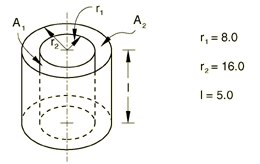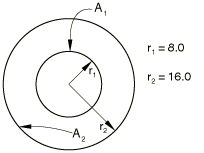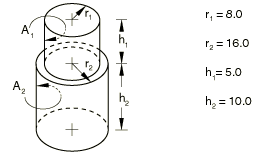Axisymmetric elemental cavity radiation view factor calculations | ||
| ||
ProductsAbaqus/Standard
Relatively simple configurations were selected for these verification problems to ensure that analytical solutions or tabulated results could be found. In some cases certain parameters such as the distance between two surfaces or the number of elements on a surface were varied to illustrate the effects of these parameters on view factor calculations within Abaqus. To duplicate the tabulated results for the cases where parameters were varied, the user can modify the input files provided with the Abaqus release.
Parallel circular disks with centers along the same normal
Problem description

Analytical solution
where , , and .
Results and discussion
The number of elements along the bottom area can be varied to obtain the following results:
| # of elements on bottom plane | F | F | ||
|---|---|---|---|---|
| Abaqus | Analytical | Abaqus | Analytical | |
| 1 | 0.6853 | 0.6800 | 0.1713 | 0.1700 |
| 2 | 0.6836 | 0.6800 | 0.1709 | 0.1700 |
| 4 | 0.6820 | 0.6800 | 0.1705 | 0.1700 |
Input files
- xrvda4n1.inp
-
DCAX4 elements are used to discretize the surfaces of the cavity; one element for the top surface and two elements for the bottom surface.
References
- Thermal Radiation Heat Transfer, Hemisphere Publishing Corporation, Washington, 3rd, 1992.
![]()
Two concentric cylinders of same finite length
Problem description

Analytical solution
and
where for any argument , , and ; and where , , , and .
Results and discussion
| F | F | ||
|---|---|---|---|
| Abaqus | Analytical | Abaqus | Analytical |
| 0.1790 | 0.1626 | 0.1042 | 0.0925 |
Input files
- xrvda4n2.inp
-
One DCAX4 element is used to discretize each surface of the cavity.
References
- Thermal Radiation Heat Transfer, Hemisphere Publishing Corporation, Washington, 3rd, 1992.
![]()
Concentric cylinders of infinite length
Problem description

Analytical solution
Results and discussion
The number of elements on each face can be increased to obtain the additional results:
| # of elements | F | F | F | |||
|---|---|---|---|---|---|---|
| Abaqus | Analytical | Abaqus | Analytical | Abaqus | Analytical | |
| 4 | 0.9983 | 1.0000 | 0.4991 | 0.5000 | 0.4409 | 0.5000 |
| 8 | 0.9962 | 1.0000 | 0.4982 | 0.5000 | 0.4597 | 0.5000 |
Input files
- xrvda4p3.inp
-
Four DCAX4 elements are used to discretize each surface of the cavity. The infinite extent of the cavity is modeled by repeating the elements in the z-direction using periodic symmetry (NR = 10).
References
- Thermal Radiation Heat Transfer, Hemisphere Publishing Corporation, Washington, 3rd, 1992.
![]()
Coaxial right circular cylinders of different radii, one on top of the other
Problem description

Analytical solution
where , , and .
If for , then receives no radiation from cylinder 1.
Results and discussion
| F | |
|---|---|
| Abaqus | Analytical |
| 0.5099 | 0.4793 |
Input files
- xrvda4n4.inp
-
DCAX4 elements are used to discretize the surfaces of the cavity; one element for the top area, and two elements for the bottom area.
References
- A Catalog of Radiation Configuration Factors, McGraw-Hill Book Company, New York, 1982.